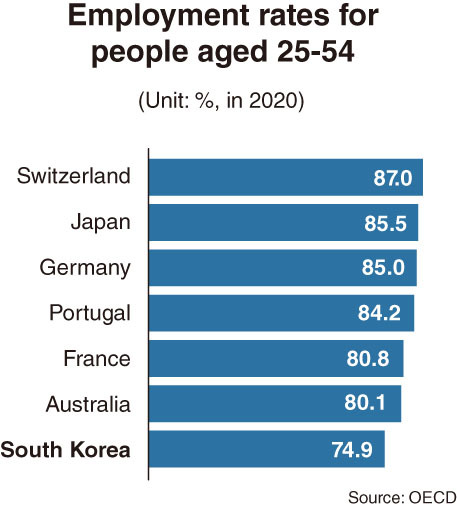[News Focus] Korea lags behind in employment for people aged 25-54
In 2020, Korea ranks 29th of 36 OECD members
By Kim Yon-sePublished : May 18, 2021 - 15:47

SEJONG -- The pandemic dealt a severe blow to South Koreans in the core-working age group – those aged between 25-54 - in terms of employment, a global comparison data showed.
According to the Organization for Economic Cooperation and Development, Korea’s employment rate for the “prime” working age population stayed at 74.9 percent last year.
The nation ranked 29th out of 36 members in the Paris-based organization’s comparison of employment for the corresponding age group. Of the total 37 OECD members, the UK was not included in the research.
Korea far lagged behind Japan, whose employment rate for the age group reached 85.5 percent (No. 4) despite the COVID-19 situation in 2020.
While Asia-Pacific neighbors such as New Zealand and Australia ranked above Korea with 83.7 percent and 80.1 percent, respectively, some emerging economies posted far higher figures: Slovenia at 88.1 percent (No. 1), the Czech Republic at 86.5 percent (No. 3) and Lithuania 83.7 percent (No. 13).

Others ranked above Korea were Poland with 83.3 percent, Estonia with 83 percent, Hungary with 82.9 percent, Latvia with 82.1 percent and the Slovak Republic with 80.5 percent.
The top 10 included Switzerland at 87 percent (No. 2), the Netherlands at 85 percent (No. 5), Sweden and Germany at 85 percent (No. 6), Iceland at 84.6 percent (No. 8), Portugal at 84.2 percent (No. 9) and Luxembourg at 84 percent (No. 10)
The average of the 27-member European Union came to 79.8 percent in the 2020 employment rate, while the OECD average posted 76.1 percent. The average of the 19 eurozone countries and the Group of 7 were 78.8 percent and 79.2 percent, respectively.
According to the Supplementary Index III for Employment, compiled by Statistics Korea, the tally for “the employed plus the underemployed” was 4.33 million at the end of 2020, with the “de facto” jobless rate reaching 14.6 percent.
This marked an increase by about 1 million, compared to 3.29 million at the end of 2019 -- who were out of work or had an unstable job position -- when the de facto jobless rate stayed at 11.1 percent.
The Index III provides a relatively new method of calculating unemployment, counting underemployed people among the de facto unemployed. This category includes those who work fewer than 36 hours a week and want to work more, as well as seasonal workers who are out of work for part of the year.
Amid a quite low vaccination rate in the nation, one worrisome point is that uncertainty is stilling lingering over the tourism, airlines, restaurants, lodging and private education sectors, which have resorted to layoffs or hiring freezes. Workers for these sectors have been hit hardest by the epidemic.
Another case for alarm is the record-breaking data on unemployment benefits each month. In 2020, the government’s yearly payouts of unemployment benefits reached an all-time high of 12.18 trillion won ($10.7 billion), compared to 8.38 trillion won in 2019.
The mounting payouts for the jobless is intensifying concerns over the government’s capacity to continue paying benefits at such high levels.
Payments had already seen a sharp increase even before the pandemic started, due to increases in the minimum wage and mass closures of small businesses under the Moon Jae-in administration.
By Kim Yon-se (kys@heraldcorp.com)



![[Herald Interview] 'Amid aging population, Korea to invite more young professionals from overseas'](http://res.heraldm.com/phpwas/restmb_idxmake.php?idx=644&simg=/content/image/2024/04/24/20240424050844_0.jpg&u=20240424200058)












![[KH Explains] Korean shipbuilding stocks rally: Real growth or bubble?](http://res.heraldm.com/phpwas/restmb_idxmake.php?idx=652&simg=/content/image/2024/04/25/20240425050656_0.jpg&u=)

